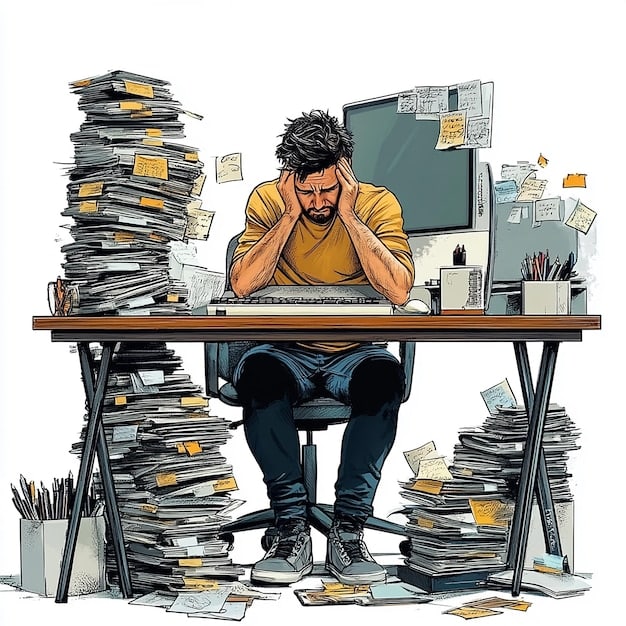Recognizing Burnout: A Guide for Men’s Mental Health

Recognizing Burnout: A Guide for Men to Identify and Address Workplace Stress offers practical steps to understand burnout symptoms, implement coping strategies, and seek professional help, tailored for men’s mental health in the demanding US work culture.
In today’s high-pressure work environment, recognizing burnout: a guide for men to identify and address workplace stress is more crucial than ever. It’s essential for men to understand the signs of burnout and take proactive steps to manage it effectively.
This guide aims to provide men in the US with practical strategies for recognizing burnout: a guide for men to identify and address workplace stress and implementing effective coping mechanisms to foster better mental health.
Understanding Burnout: A Guide for Men to Identify and Address Workplace Stress
Burnout is a state of emotional, physical, and mental exhaustion caused by prolonged or excessive stress. It’s not merely feeling tired; it’s a deeper level of depletion that can affect all areas of life. Recognizing the specific signs and triggers is the first step toward managing it effectively.
Common Symptoms of Burnout in Men
Men often experience burnout differently than women, sometimes masking their feelings or exhibiting different behavioral patterns. Recognizing these symptoms is crucial for early intervention:
- Chronic Fatigue: Persistent tiredness that doesn’t improve with rest.
- Increased Irritability: Becoming easily frustrated or short-tempered.
- Reduced Performance: Difficulty concentrating and decreased productivity.
- Physical Symptoms: Headaches, stomach issues, and sleep disturbances.
These symptoms can manifest subtly, making it essential to be vigilant and self-aware.
The Unique Challenges Men Face
Societal expectations often pressure men to be strong and stoic, which can prevent them from seeking help. Understanding these pressures is important in addressing burnout effectively:
- Stigma Around Mental Health: Fear of judgment or appearing weak.
- Workplace Culture: Environments that prioritize overwork and long hours.
- Personal Expectations: Internal pressure to succeed and provide.
Breaking down these barriers is essential for men to prioritize their mental health.

Recognizing these symptoms and challenges helps men take the first step toward recovery and better mental well-being. Identifying Recognizing Burnout: A Guide for Men to Identify and Address Workplace Stress early on allows for prompt and effective intervention.
Identifying the Root Causes of Workplace Stress
Workplace stress is a significant contributor to burnout. Understanding the root causes allows for targeted interventions to reduce stress and prevent escalation to burnout. Identifying these stressors is crucial for developing effective coping strategies.
Workload and Time Pressure
Excessive workload and tight deadlines can create immense stress, leading to feelings of overwhelm and inability to cope:
- Unrealistic Deadlines: Pressure to complete tasks in insufficient time.
- Constant Multitasking: Juggling multiple responsibilities simultaneously.
- Lack of Control: Feeling unable to manage workload or prioritize tasks.
Addressing these issues can significantly reduce workplace stress.
Interpersonal Conflicts and Lack of Support
Negative relationships and lack of support can amplify stress and contribute to feelings of isolation and burnout:
- Difficult Colleagues: Dealing with negativity, conflict, or bullying.
- Poor Communication: Lack of clear information and feedback.
- Insufficient Support: Feeling unsupported by management or peers.
Supportive relationships and clear communication are vital for a healthy work environment.
Work-Life Imbalance
The blurring of boundaries between work and personal life can lead to chronic stress and burnout. This imbalance can be especially harmful for men, who may feel pressured to prioritize work:
- Always-On Culture: Expectation to be available outside of work hours.
- Inability to Disconnect: Difficulty separating from work mentally and emotionally.
- Neglecting Personal Needs: Sacrificing sleep, exercise, and hobbies.
Setting healthy boundaries is essential for maintaining work-life balance and preventing burnout.
By identifying and addressing these root causes, men can take proactive steps to reduce workplace stress. Creating a healthier work environment is crucial for recognizing burnout: a guide for men to identify and address workplace stress and promoting overall well-being.
Practical Strategies for Coping with Burnout
Effective coping strategies are essential for managing burnout and restoring balance. These strategies focus on self-care, boundary setting, and seeking support, all critical for men’s mental health.
Implementing Self-Care Practices
Self-care is not selfish; it’s essential for maintaining mental and physical health. Simple daily practices can make a significant difference:
- Regular Exercise: Physical activity to release stress and boost mood.
- Adequate Sleep: Prioritizing 7-9 hours of quality sleep per night.
- Healthy Diet: Nourishing the body with nutritious foods.
These practices help to replenish energy and reduce stress levels.
Setting Boundaries at Work
Establishing clear boundaries can prevent overwork and protect personal time. This includes:
- Defining Work Hours: Sticking to a set schedule and avoiding overwork.
- Saying No: Declining additional responsibilities when already overwhelmed.
- Disconnecting After Work: Avoiding emails and work-related tasks during personal time.
Setting boundaries helps maintain a healthy work-life balance.
Seeking Support and Professional Help
Seeking support is a sign of strength, not weakness. Talking to someone can provide valuable perspective and guidance:
- Talking to Trusted Friends or Family: Sharing feelings and experiences with loved ones.
- Joining Support Groups: Connecting with others who understand burnout.
- Seeking Professional Therapy: Working with a therapist to develop coping strategies.

Creating a support system is crucial for managing burnout. Implementing these practical strategies can significantly reduce burnout symptoms. It is integral to recognizing burnout: a guide for men to identify and address workplace stress early on and making continuous efforts to combat it.
Building Resilience to Prevent Future Burnout
Building resilience is about developing long-term strategies to manage stress and prevent burnout from recurring. This involves cultivating a positive mindset, developing problem-solving skills, and maintaining healthy relationships.
Cultivating a Positive Mindset
A positive mindset can significantly impact how you perceive and respond to stress:
- Practicing Gratitude: Focusing on the positive aspects of life.
- Reframing Negative Thoughts: Challenging negative thoughts and replacing them with positive ones.
- Mindfulness Meditation: Practicing mindfulness to stay present and reduce anxiety.
A positive outlook can help manage stress more effectively.
Developing Problem-Solving Skills
Effective problem-solving skills can reduce stress by providing a sense of control and competence:
- Breaking Down Problems: Dividing large tasks into smaller, manageable steps.
- Seeking Solutions: Brainstorming and evaluating potential solutions.
- Learning from Mistakes: Viewing failures as opportunities for growth.
Problem-solving skills can increase resilience and reduce feelings of overwhelm.
Maintaining Healthy Relationships
Strong social connections can provide support and buffer against stress:
- Nurturing Relationships: Investing time and effort in meaningful relationships.
- Seeking Social Support: Reaching out to friends and family during challenging times.
- Setting Relationship Boundaries: Maintaining healthy boundaries to avoid emotional depletion.
Supportive relationships are vital for resilience. Promoting resilience is an ongoing process. Staying vigilant about Recognizing Burnout: A Guide for Men to Identify and Address Workplace Stress and being proactive in implementing strategies to mitigate its risks, men can safeguard their mental health and sustain their professional and personal well-being.
Resources and Further Support for Men’s Mental Health
There are numerous resources available to support men’s mental health. Knowing where to find help can make a significant difference. Utilizing these resources is a proactive step in recognizing burnout: a guide for men to identify and address workplace stress and seeking assistance.
Mental Health Organizations and Websites
Several organizations offer valuable information, support, and resources for men’s mental health:
- The National Institute of Mental Health (NIMH): Provides research-based information on mental health disorders.
- The Anxiety and Depression Association of America (ADAA): Offers resources and support for anxiety and depression.
- The Mental Health America (MHA): Advocates for mental health and provides resources for individuals and communities.
These resources can provide valuable information and support.
Therapy and Counseling Options
Therapy and counseling can provide professional guidance and support for managing burnout:
- Cognitive Behavioral Therapy (CBT): Helps identify and change negative thought patterns.
- Mindfulness-Based Therapy: Combines mindfulness practices with therapy to reduce stress.
- Online Therapy: Provides convenient access to therapy from home.
Professional support can be highly effective in managing burnout.
Books and Articles on Men’s Mental Health and Burnout
Reading books and articles can provide additional insights and strategies for managing burnout and promoting mental health:
- “Man’s Search for Meaning” by Viktor Frankl: Explores finding meaning in life through challenging circumstances.
- “The Body Keeps the Score” by Bessel van der Kolk: Discusses the impact of trauma on the body and mind.
- Articles on the Harvard Business Review: Offers practical advice on managing stress and burnout in the workplace.
These resources can provide additional support and guidance.
Utilizing these resources can provide the necessary support for recognizing burnout: a guide for men to identify and address workplace stress and its associated challenges. Accessing these resources is a proactive step towards managing one’s mental health.
| Key Point 🔑 | Brief Description |
|---|---|
| 😔 Symptoms | Identify emotional, physical, & mental exhaustion signs. |
| 🎯 Root Causes | Recognize workload, conflict, & imbalance contributors. |
| 💪 Coping | Apply self-care, set boundaries, & seek support. |
| 🌱 Resilience | Build positivity, problem-solve, & maintain relationships. |
Frequently Asked Questions
Early signs include increased irritability, chronic fatigue, difficulty concentrating, and physical symptoms like headaches or stomach issues. Recognizing Burnout: A Guide for Men to Identify and Address Workplace Stress includes being mindful of these changes.
Define your work hours, learn to say no to additional responsibilities, and disconnect from work-related tasks during your personal time. This helps maintain a healthier work-life balance and prevent overwork.
Men can find support from mental health organizations, support groups, and professional therapists. It’s important to seek help from trusted friends, family, or mental health resources to address concerns surrounding Recognizing Burnout: A Guide for Men to Identify and Address Workplace Stress.
Regular exercise, adequate sleep, a healthy diet, and mindfulness practices can significantly reduce stress levels and help replenish energy. Prioritizing these self-care activities is essential for managing burnout.
Cultivate a positive mindset, develop effective problem-solving skills, and maintain healthy relationships. These practices help buffer against stress and promote long-term well-being crucial to Recognizing Burnout: A Guide for Men to Identify and Address Workplace Stress.
Conclusion
Recognizing burnout: a guide for men to identify and address workplace stress is a crucial step toward improving men’s mental health. By understanding the symptoms, identifying root causes, and implementing practical strategies, men can effectively manage burnout and build resilience.
Prioritizing self-care, setting boundaries, seeking support, and leveraging available resources are key components of a comprehensive approach to preventing and overcoming burnout, ultimately leading to improved well-being and a healthier work-life balance.





